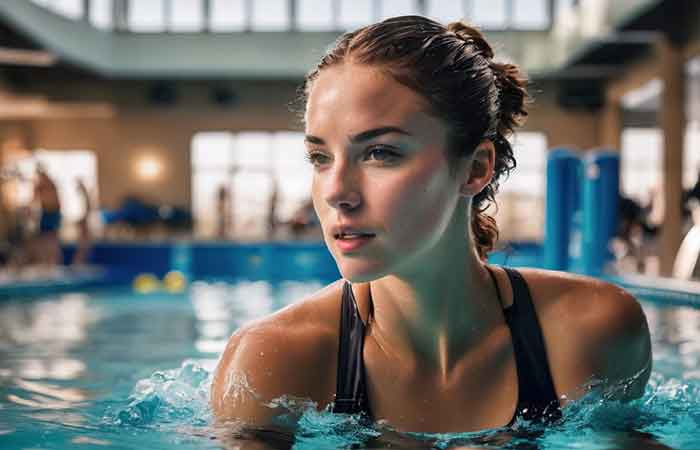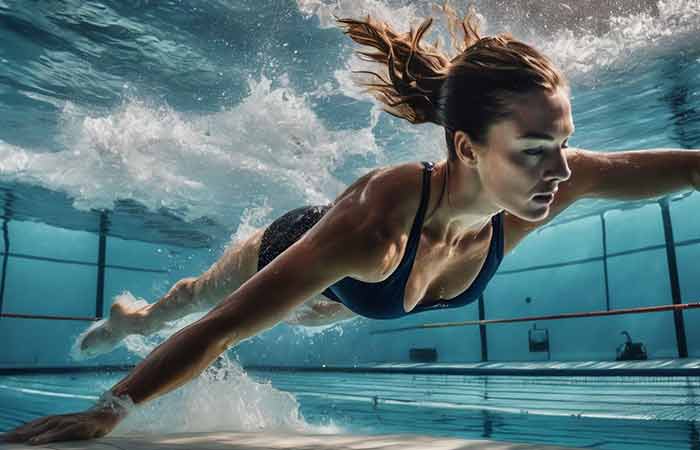How to Swim Backstroke-Technique, Drills & Tips
The backstroke, also known as the back crawl, is the only technique that’s swum on the back in competitions such as the Olympics. It entails swimming while facing upwards, for easy breathing, with the arms moving in an anti-clockwise manner towards the direction you’re going using flutter kicks. It is actually a front crawl but done in reverse.
Following is a complete guide on the backstroke swim style is performed, the technique comprising of the arm and leg movement, body and head position, breathing plus drills and tips for both beginners and advanced swimmers.
Technique
The backstroke starts with the swimmer flat on their back. Your hands should be stretched above your head and the legs also extended flat. The focus is to make the body as flat as possible which is great when it comes to swimming.
1. Arm Movements
The backstroke generates a majority of the propulsion from the movements of the hands. For this reason, you have to get the technique right at all times. The arm movements in this style occurs in two phases namely the power phase and the recovery phase.
The arms move in an alternating manner such that, when one arm is under the water, the other one is recovering. The body also moves side to side to aid in the generation of power in the arms. For an arm to complete a cycle, it must turn through 360° first.
The power phase of the arm has three parts the first of which is the catch phase. In this part, the arm will sink into the water to catch the water at an angle of 45 degrees. The fingers should be together to catch as much of the water as possible. The palm should also be perpendicular to the floor of the pool.
The second part of the power phase is the mid-pull and entails moving the arm in a semi-circle from the catch phase to the side of your hips. The elbow should point at the bottom of the pool to catch the maximum amount of water with the arm.
The last phase of the power phase is the push which entails the palms flapping downwards and backwards to propel the body forwards. This push downwards helps push you ahead and to the other side when the other arm is just completing its recovery phase. This stage can have the fingers apart slightly to increase the palm’s surface area.
The recovery phase starts with pointing the palms towards the legs and thumb upwards. This occurs when the other arm is starting the power phase. The arm in the recovery phase moves from besides the hips in a semi-circle to the front of the head while keeping a straight profile. To make the most of the recovery, you should put the arm into the water with the little finger first. This way, your arm will experience very little resistance going in. It saves on energy and time.
There are various variations to the arm movements for the backstroke. They include the following:
- You can move the arms together rather than in an alternating manner. This stroke has been found to be faster and easier to coordinate. The only downside to it is that it takes longer to recover and there’s a window in which the body isn’t being propelled by the arms. As such, it’s generally slower than the alternating arm technique. This stroke is called the elementary backstroke and is like an inverted breaststroke.
- The other variation is the paused stroke in which only one arm is used to pedal while the other one rests. Of course, it’ll be slower than using both arms. However, it’s great for teaching beginners holding unto a float or simply finding it hard matching the two arms simultaneously. It may, however, lead to a paused stroke which is a bad habit for swimmers as it reduces their speed.
- The last major iteration is the windmill movement. In this variant, the arms remain straight and move in complete circles rather than the adjustments described in the original stroke. While entertaining to watch, it’s a tough one as it often leads to shoulder injuries and not very efficient at gaining speed.
Once you master the primary stroke, adding these variations can be a fun way to swim.
2. Leg Movements
The leg movements in the backstroke are similar to those in the freestyle stroke as they’re both flutter kicks. The kicks are important as they stabilize the body while giving it significant propulsion forwards.
From a starting of position of straight legs, the first leg moves downwards into the water about 30 degrees from the horizontal plane. The knee bends slightly such that the lower leg is deeper into the water than the thigh region.
The leg then kicks upwards with the lower leg kicking last to push the water away from the body. As one foot kicks, the other one deeps into the water. In the end, they’ll be going up and down in quick succession. Often, the legs can move the same cycles with the strokes of the hands. However, many variations exist with 2, 4, or even 6 kicks. The expertise of the swimmer also plays a part in this.
There are some variants to the simple flutter kick including using the butterfly kick rather than the flutter kicks. This occurs in rare occasions as its difficult to pull off especially for beginners. While the butterfly kick is much faster than the flutter kicks, it’s not very beneficial for this type of swimming style.
3. Breathing Technique
It’s much easier to breath with this stroke as the mouth and nose are always above the water. While you can breath as you please, matching your breathing with parts of the strokes helps you focus better and thus move faster.
As such, most experienced swimmers prefer breathing based on the movements of one arm. For example, they breath in as the arm recovers and out when the arm is in the push phase. This technique also makes it easy to eliminate water from the nose.
4. Body Movements
The primary focus with this stroke is to have a horizontal and straight body at all times. With the strokes making your body move from side to side along an axis, you may easily lose focus and dip the hips low. This will only increase the drag on your body leading to reduced speeds.
To avoid the mistake of dipping your hips and lower body into the water, you need to move the upper legs into the down position as much as you can with each flutter kick. Hold the head out of the water to counteract the weight of the lower back. Like with all swimming styles, the area from your navel to the groin is the fulcrum of your body. To balance one side, simply add weight to the other side.
You can also make use of the side to side motion of the body to generate more power. This occurs when you use the arm and shoulder muscles together to power the strokes rather than the hands alone.
5. Starting
For competitions, the backstroke has a very unique start. It’s the only one where swimmers start from the water and not on the platforms. Swimmers will face the wall while holding unto it. Most swimming pools have grips specifically for this just below the start blocks.
Your feet will be on the wall with the heels off that wall. For an ideal start, place your feet about shoulder width apart from each other. The knees should be at 90-degree angles to give you the force you need backwards.
When taking off, you throw your hands and head backwards. A large part of the propulsion should come from the knees pushing away from the start block. As you become airborne, arch your back such that the lowest points on your body are the hands and the feet.
This allows your hands and feet to touch the water first. This will reduce the drag on your body as you land.
As your hands touch the water, quickly breath in and slowly exhale as you become submerged. Once underwater, make flutter kicks for a period of time then start the strokes.
6. Turning and Finishing
When turning in the water, it’s difficult seeing where you’re going as you’ll be facing upwards. The options include knowing the strokes it takes to cover a certain distance, the strokes needed after flagging off the race, the color of the separating lines for the pool, or the color of the ceiling (although not very accurate). While turning your head is also an option, you’ll waste lots of time.
Previously, swimmers would have to touch the wall with both hands while still on their backs. That changed in 1992 and now they can turn on their bellies, touch the wall with one or both arms then start off the next trip.
For the finish, however, you’re still needed to touch the wall with both of your hands while on your back. Your body should be at least 90 degrees to the horizontal plane for it to count as a finish.
Drills and Tips
Beginner tips and drills
Drills for competitive swimmers
Benefits
Following are some of the advantages of the back crawl
- The fact that you can easily breath means that you can go on for longer periods of time without burning a lot of gas and energy.
- Just like other strokes, it a good way to exercise your shoulders, back, arms, legs and your core muscles
Drawbacks
While it has the advantage of easy breathing, in the past swimmers didn’t know exactly where they were going. With modern swimming pools, however, that has been largely put to rest with the use of demarcated lanes for each swimmer.
Even with the demarcated lines, some swimmers still have the fear of banging their heads into the walls of the swimming pool.
The lane ropes can also be distraction for backstroke swimmers
History
The backstroke is directly derived from the front crawl or free style. This can be seen from the many similarities between the two swimming styles. In fact, the two styles are so similar that mastering one puts the swimmer quite ahead in mastering the other.
Originally started as an offshoot of the freestyle stroke, the backstroke gained interest from different swimmers who would develop it further to gain speed and save on energy.
One area that was well-developed was the bending of the arms when they went under the water. This proved to provide more propulsion than the straight arm technique.
When first introduced, swimmers would go for up to 35 meters under the water doing the dolphin kick where they gained speed before surfacing. This was changed to the current 15 meter restriction underwater in 1991 by the swimming governing body FINA.
One most notable difference between this style and the others is the turning. While other styles require that you use both of the your hands on the wall, FINA has allowed for the swimmers to use any part of their body to turn. his is based on the fact that swimmers don’t see where they’re going as much as in the other styles.
The backstroke became the second swimming style after the freestyle to be integrated into sports with the first backstroke competitions held in the 1900 Paris Olympic Games. The event was for men in a 200m swim. The next Olympic Games (1904) would integrate the 100-yard swim.
At the moment, there are 100m and 200m for both men and women in the backstroke style at swimming events such as the Olympics. With a standard swimming pool measuring 50m, a 200m swim means that they swim 4 lengths one length after the other.
Top Backstroke Swimmers
- Ryan Murphy (USA). Current champion. won 2016 Rio Olympics
- Aaron Piersol (USA) Retired in 2009 with five Olympic gold medals
- Lenny Krayzelburg (USA). Champion in the 1990s. Set many world records with four Olympic gold medals
- Krisztina Egerszegi (HUN). Won 200m backstroke event in 3 consecutive Olympic Games from 1988 to 1996.
- David Berkoff (USA) & Daichi Suzuki (JPN). They came up with the underwater dolphin kicking.
To conclude, the backstroke, while a direct derivation of the freestyle swimming style, requires more technique to master than its original. Even when you’ll be facing upwards making it easy to breath, there’s the increased likelihood of water getting into your nose and distracting you.
Other problems noted above include failing to keep a flat profile, poor hand techniques. With proper training and focus on your end, you can overcome these issues with ease and make the most of the style. The good news is that, once you’ve mastered the freestyle swim, you’ll be in a great position to master this one as well
Further Reading
Following is a list of articles with more swimming information and other water sports
Swimming Strokes/Styles
- Different Types of Swimming Strokes, Styles & Names
- What is Sculling in Swimming? How to do it
- How to Tread Water- Techniques, Benefits & Exercises
- How to Swim Freestyle: Technique, Tips & Drills
- How to Swim Breaststroke: Kick, Pull, Form, Drills & Tips
- Butterfly vs Breaststroke Swimming
- How to Swim Elementary Backstroke- Technique, Drills & Tips
- How to Swim Sidestroke-Technique,Trudgen &Combat Drills & Tips
- How to Swim Butterfly: Technique, Drills & Tips
Swimming FAQs & Ideas
- How Many Calories Does Treading Water Burn?
- Can you Swim with Contacts in the Ocean/Pool?
- Can you Open your Eyes in the Salty Ocean or Chlorinated Pool Waters?






